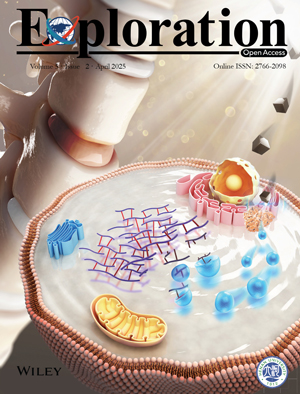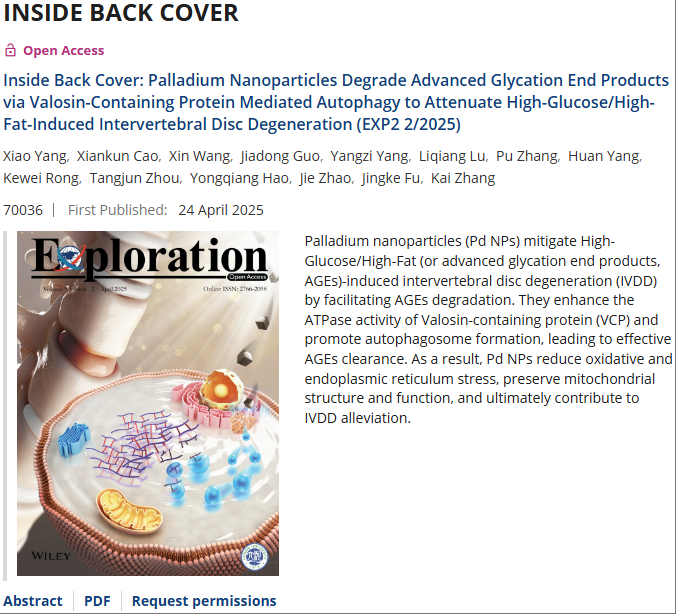The cover of this issue of Exploration is “Palladium Nanoparticles Degrade Advanced Glycation End Products via Valosin-Containing Protein Mediated Autophagy to Attenuate High-Glucose/High-Fat-Induced Intervertebral Disc Degeneration” published by Professor Zhao Jie, Associate Chief Physician Zhang Kai, and Assistant Researcher Fu Jingke from the Ninth People’s Hospital Affiliated to Shanghai Jiao Tong University School of Medicine.
Volume5, Issue2
Xiao Yang, Xiankun Cao, Xin Wang, Jiadong Guo, Yangzi Yang, Liqiang Lu, Pu Zhang, Huan Yang, Kewei Rong, Tangjun Zhou, Yongqiang Hao, Jie Zhao, Jingke Fu, Kai Zhang

Research background
Intervertebral disc degeneration (IVDD) is a chronic musculoskeletal disease that causes low back pain and imposes a heavy burden on global health. The high blood sugar caused by diabetes mellitus promotes the accumulation of advanced glycation end products (AGEs) in nucleus pulposus cells, an important mechanism for IVDD. Reducing the accumulation of AGEs has become a novel and promising strategy for IVDD management.
Research significance
This study found that palladium nanoparticles (Pd NPs) can be preferentially localized in the endoplasmic reticulum and effectively degrade AGEs through the autophagy pathway mediated by valosin-containing protein (VCP), which is specifically manifested by promoting the ATPase activity of VCPs, upregulating the expression of microtubule-associated protein 1A/1B light chain 3 (LC3), and increasing the production of AGEs-degrading autophagosomes. At the same time, it improves mitochondrial function, alleviates endoplasmic reticulum stress, and offsets the oxidative stress microenvironment in the high-glucose/high-fat-induced nucleus pulposus cell degeneration model. It effectively rescues nucleus pulposus cell degeneration in vitro experiments, restores intervertebral disc height, and partially restores the degenerative phenotype of IVDD in vivo experiments, providing new insights into the management of IVDD by targeting AGEs degradation and demonstrating clinical application potential.
Research prospects
Based on the good therapeutic effects of Pd NPs on IVDD both in vivo and in vitro in this study, further in-depth research can be carried out in the future, such as optimizing the preparation process of Pd NPs to improve its stability and biocompatibility, expanding the sample size for more comprehensive clinical trials to verify its safety and effectiveness, and exploring the possibility of combining Pd NPs with other treatment methods to improve the overall efficacy, to promote the transformation of this research results into clinical practice and provide more effective treatment options for IVDD patients.
Cover design process

The cover design closely revolves around the theme of the paper, showing the process of palladium nanoparticles (Pd NPs) degrading advanced glycation end products (AGEs) in cells from a microscopic perspective. The figure shows various structures in the cell, such as the endoplasmic reticulum, mitochondria, autophagosomes, etc., as well as the interaction between Pd NPs and these structures, which intuitively conveys the core research content of the paper.
The overall color matching is soft and technological. The background uses light tones to create a clean and professional atmosphere. The cell structure and Pd NPs use bright colors such as blue, pink, and yellow, making these key elements stand out from the background and attract readers' attention.
The cover adopts the style of scientific illustrations, combined with 3D modeling technology, making the display of cell structure and nanoparticles more realistic and three-dimensional. This style not only enhances the visual effect, but also helps readers better understand complex scientific concepts. The cell structure and Pd NPs in the figure have been finely 3D modeled. The morphology and structure of organelles such as the endoplasmic reticulum and mitochondria are accurately presented, and the shape and distribution of Pd NPs are also carefully depicted. This kind of detailed modeling makes the cover not only have artistic value, but also have scientific educational significance. In the end, the cover was highly recognized by teachers and journal editors and was successfully published!
Our hours
Beijing time: 9:00-18:00